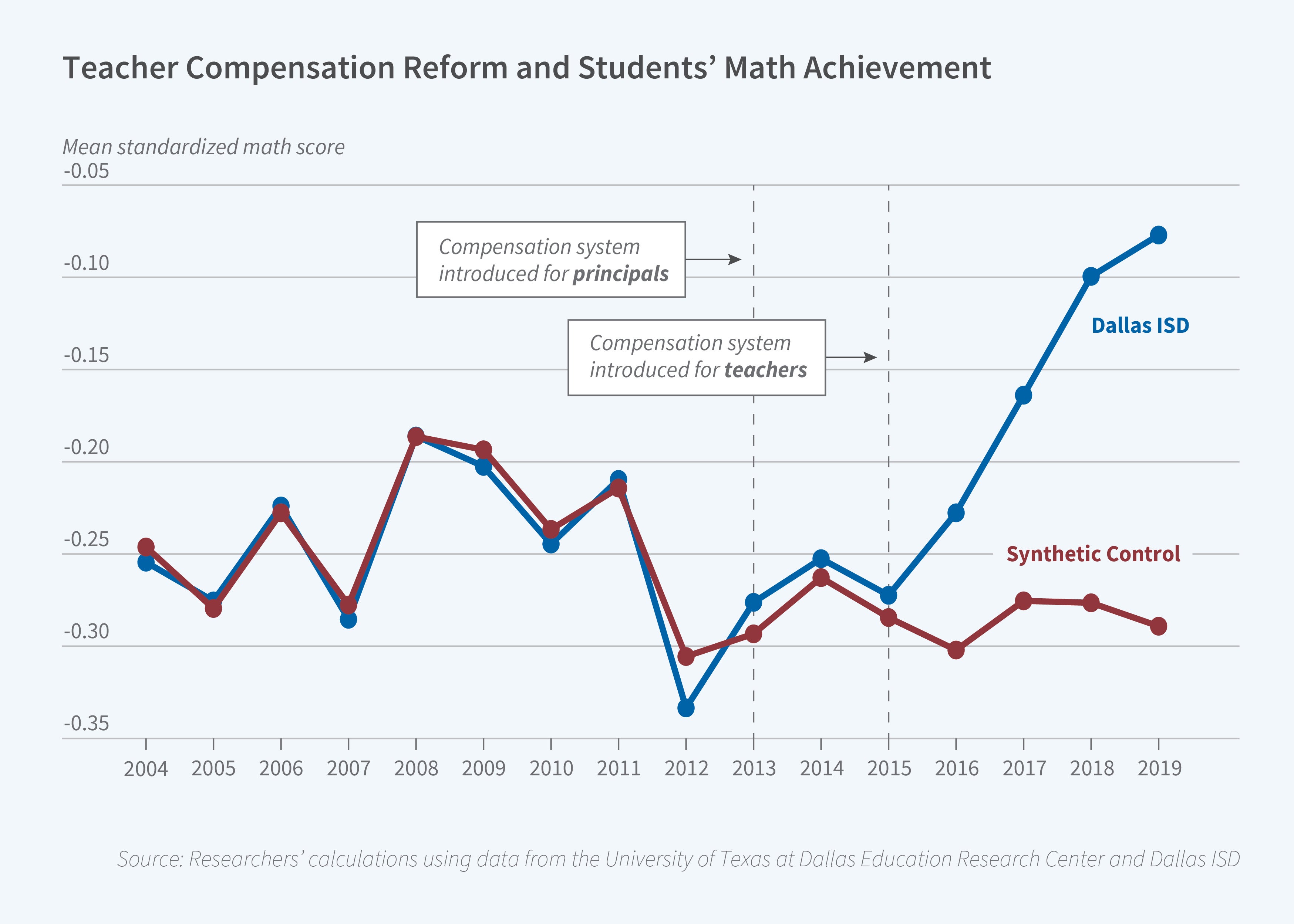Dallas Initiatives Centered on Teacher Pay Show Strong Results

Over the last decade, the Dallas Independent School District (ISD) has dramatically changed how it sets salaries. Jettisoning a typical pay scale tied to years of experience and academic credentials, Dallas began compensating educators based on a rigorous evaluation system. The result, according to two recent, related studies, is a marked improvement in student achievement.
In The Effects of Comprehensive Educator Evaluation and Pay Reform on Achievement (NBER Working Paper 31073), Eric A. Hanushek, Jin Luo, Andrew J. Morgan, Minh Nguyen, Ben Ost, Steven G. Rivkin, and Ayman Shakeel show that the new system increased the achievement levels of Dallas students above those of students enrolled in comparable schools with traditional pay scales elsewhere in Texas.
Identifying effective teachers and principals and providing financial incentives for them to work in lagging schools raises achievement test scores in math and reading.
Under the Principal Excellence Initiative, introduced in 2013, and the Teacher Excellence Initiative, which followed two years later, the Dallas ISD pays educators based on their contributions to student achievement, supervisor observations, student or family feedback, and, in the case of principals, efforts to support teacher improvement. As an incentive to focus on disadvantaged students, principals are also judged on progress in reducing achievement gaps between their students and the district mean. Based on aggregate evaluation scores, educators are sorted into rating bins that are the primary factor in setting their salaries.
As their main control group, the researchers used schools drawn from the 20 largest Texas districts with at least 60 percent low-income students. The impact of the Dallas reforms became clear in 2016 when, after an initial period of high teacher turnover, math and to a lesser extent reading achievement scores rose. Prior to introduction of the new salary scheme, scores in both the Dallas schools and the control group, which serve large shares of disadvantaged students, were substantially below the statewide mean; afterward, the students in Dallas rose to nearly the state mean level, while the control group did not improve.
Though initially disruptive, the teacher turnover resulted in a stronger staff, as teachers who left the system on average had lower evaluation scores than those who remained. The analysis attributes 15 percent of the improvement in math achievement to changes in the composition of the teaching staff. Other key contributing factors included higher incentives, enhanced teacher support, and stronger school leadership.
In Attracting and Retaining Highly Effective Educators in Hard-To-Staff Schools (NBER Working Paper 31051), Morgan, Nguyen, Hanushek, Ost, and Rivkin report that Dallas obtained immediate and sustained improvements in student achievement in its lowest-ranked schools by using the new evaluation system to identify talented teachers and reward them with stipends if they worked at those schools.
The Accelerating Campus Excellence (ACE) program was launched with four schools in 2016 and expanded to nine schools in 2018. Teachers were paid effectiveness-based stipends of up to $10,000 and administrators up to $13,000 for working at low-performing schools. Existing teachers who wanted to remain at the targeted schools underwent a rigorous screening process, resulting in less than 20 percent of them being retained.
The program selected the worst performing schools based on test scores from 2014, two years before it was implemented. The researchers used as a control group the next-lowest-performing schools in Dallas, a group exposed to similar conditions in the run-up to the program’s implementation.
Overall, the program raised average achievement at the lowest-performing schools nearly to the districtwide average. Math scores saw greater gains, but reading increases were substantial as well. Students who attended targeted schools for two or more years continued to show large increases in achievement in middle school, suggesting lasting improvements in cognitive skills. The second wave of students showed similar results to those in the first, demonstrating that the program could be scaled up.
Ironically, the rewards system’s success resulted in its undoing. When achievement scores at the targeted schools in the first wave approached the district average, stipends were largely removed. Consequently, the researchers write, “turnover jumped among the most effective teachers and test scores fell substantially.”
—Steve Maas
This research was supported by grants from the Arnold Foundation and from the CALDER Research Network.


